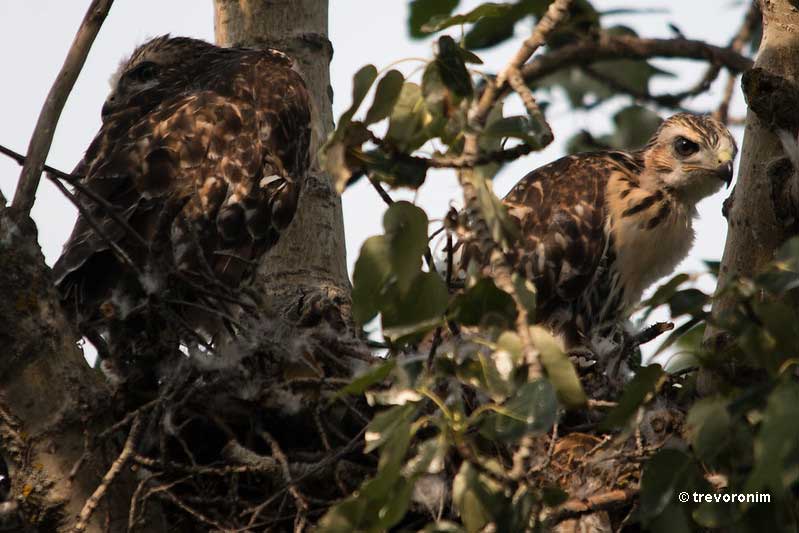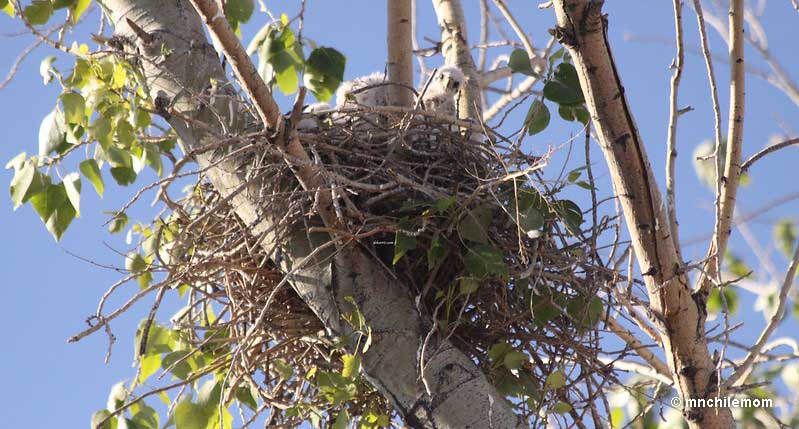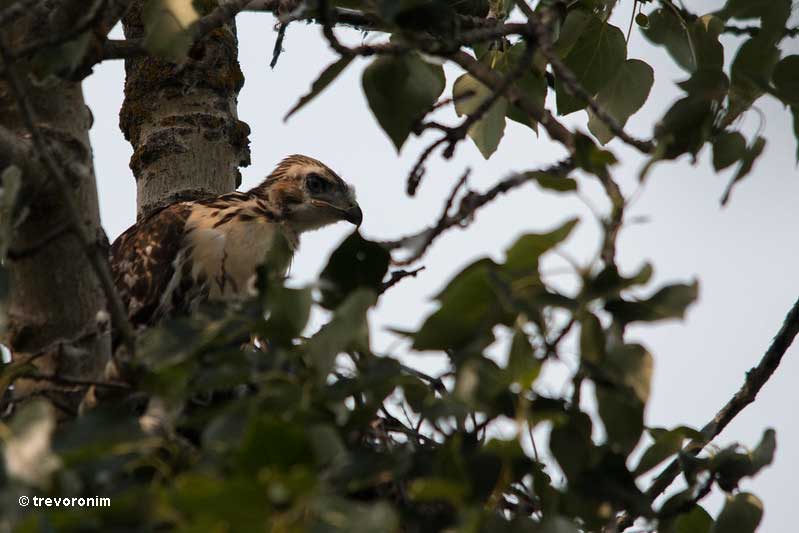
Baby hawks are as cute and fuzzy as other baby birds. When a baby hawk (known as an “eyas”) hatches, it can barely move.
Similar to other baby birds, baby hawks spend a lot of their time begging for food. Unlike baby birds of other species, a baby hawk can eventually become aggressive with its siblings and will use its sharp bill and talons to attack and eat food items brought to it by its parents.
Here’s everything you need to know about baby hawks.
On this page
Nest
Hawk nests are usually built in a tall or isolated tree, or other site that has a clear view of the surrounding habitat.
In the case of the Red-tailed Hawks, in urban areas, they can also nest on buildings, windmills, or other structures. The nest is a bulky and obvious, two-foot wide structure made of sticks and some green vegetation and can be an old, refurbished nest, or a new one.
Usually, two to three pale eggs with some reddish-brown speckling are laid and incubated by both parents for a month.
After hatching, baby hawks are completely dependent on their parents for at least a month. At first, the nestling hawks are more or less immobile but start to move their wings and make noise after a few days.
They grow quickly and after a week, will peck at food items brought by their parents. As they continue to grow, they become more active and can make some use of their talons and beak to defend themselves.
After 45 days, the baby hawks finally leave the nest but are still occasionally fed by both parents for several weeks or months.
What Does A Baby Hawk Look Like?
A baby hawk looks like a pale and fuzzy bird with the sharp beak of a raptor, and over-sized feet with sharp talons.
On the first day after hatching, they have their eyes closed, weigh 58 grams, and lie in the nest without moving or making any noise. As the adults feed them, they quickly gain weight, and the beak, feet, and talons grow faster than other parts of the baby bird.
Related: When do birds start laying eggs?
During the third and fourth weeks of their lives, baby hawks greatly increase in size and become covered in the feathers needed for flight.
After around a month, the size difference between male and female birds is apparent with females being noticeably larger than males.
The baby hawks are brooded (kept warm) by their mother. She also preens their feathers during brooding and waiting for the male to bring food.
After the baby hawks leave the nest, they practice flying and still call for their parents for a few weeks or even months later. At this stage, they look a lot like adults but usually have a dark eye, more streaking on the underparts, and more camouflaged plumage in general.
How To Tell Baby Hawks Apart?
In the nest, baby hawks can be recognized by their pale and fuzzy plumage combined with a sharp, hooked beak, and over-sized feet with talons.
Related: Baby Birds – From Hatching to Adulthood
In general, they look like miniature, pale and downy versions of their parents, and make a lot of high-pitched whistling or piping calls.
After leaving the nest, even though baby hawks are around the same size as their parents and also look pretty similar, they can still be recognized as young birds by their streaked and more camouflaged plumage.
They also like to pick a perch and stay there for a while as they make repetitive, high-pitched calls until their parents bring them something to eat.
What Do Baby Hawks Eat?
After hatching, baby hawks are fed a combination of regurgitated food and bits of meat by their mother for the first five days.
After that, they continue to be fed small bits of meat torn from prey items by their parents for five weeks. The male brings most of the food to the nest and gives it to the female.
For the fifth and final two weeks before leaving the nest, small animals and other dead prey are brought to the young birds. The nestlings tear apart these prey items on their own and feed themselves.
Related: What do baby birds eat?
After leaving the nest, baby hawks start to hunt and kill their own food but since they still need to learn how to hunt and can’t usually catch enough food to survive on their own, the adults continue to feed the young birds from time to time for a couple months.
Frequently Asked Questions
What does a hawk fledgling look like?
A hawk fledgling looks like an adult hawk with streaked and heavily marked plumage, has large feet, and patches of white down interspersed with larger feathers.
What is the name of a baby hawk?
A baby hawk is called an “eyas”.
What does an immature hawk look like?
An immature hawk looks very much like an adult and is the same size but has more streaked and camouflaged plumage.
How can you tell a juvenile hawk?
We can tell a juvenile hawk by its streaked or mottled plumage with some white patches of fuzzy down feathers, a tendency to make frequent, high-pitched calls, and its unwary behavior.
Read next: What to do if you find a baby bird



